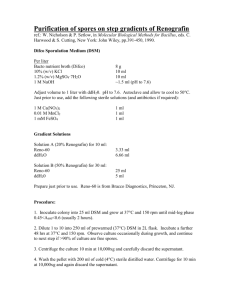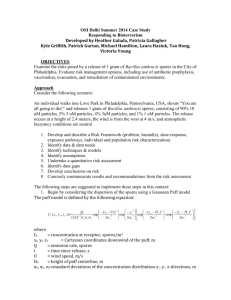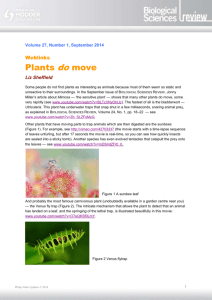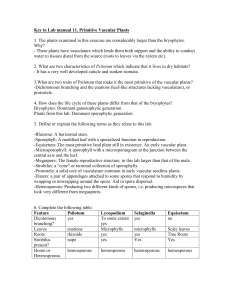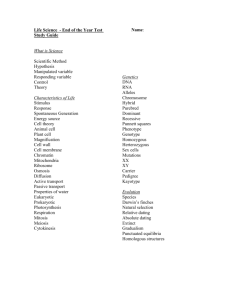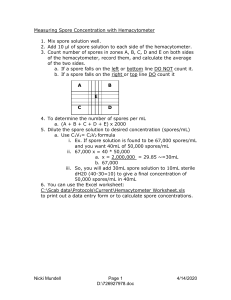Mechanism of killing of spores of Bacillus cereus and Bacillus
advertisement
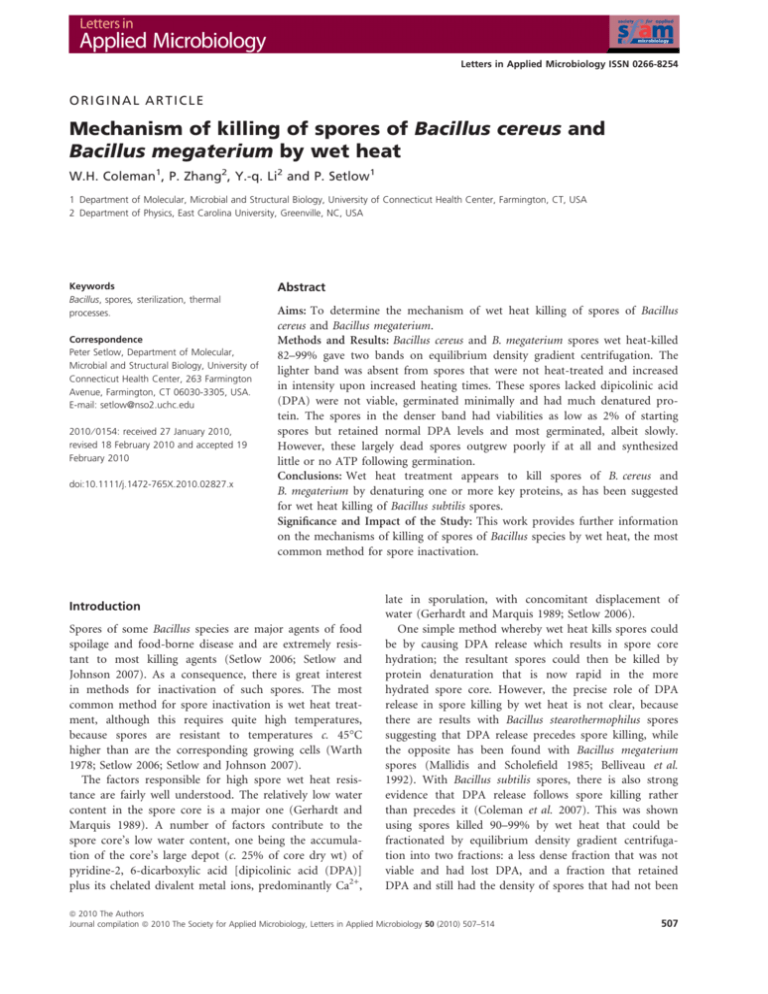
Letters in Applied Microbiology ISSN 0266-8254 ORIGINAL ARTICLE Mechanism of killing of spores of Bacillus cereus and Bacillus megaterium by wet heat W.H. Coleman1, P. Zhang2, Y.-q. Li2 and P. Setlow1 1 Department of Molecular, Microbial and Structural Biology, University of Connecticut Health Center, Farmington, CT, USA 2 Department of Physics, East Carolina University, Greenville, NC, USA Keywords Bacillus, spores, sterilization, thermal processes. Correspondence Peter Setlow, Department of Molecular, Microbial and Structural Biology, University of Connecticut Health Center, 263 Farmington Avenue, Farmington, CT 06030-3305, USA. E-mail: setlow@nso2.uchc.edu 2010 ⁄ 0154: received 27 January 2010, revised 18 February 2010 and accepted 19 February 2010 doi:10.1111/j.1472-765X.2010.02827.x Abstract Aims: To determine the mechanism of wet heat killing of spores of Bacillus cereus and Bacillus megaterium. Methods and Results: Bacillus cereus and B. megaterium spores wet heat-killed 82–99% gave two bands on equilibrium density gradient centrifugation. The lighter band was absent from spores that were not heat-treated and increased in intensity upon increased heating times. These spores lacked dipicolinic acid (DPA) were not viable, germinated minimally and had much denatured protein. The spores in the denser band had viabilities as low as 2% of starting spores but retained normal DPA levels and most germinated, albeit slowly. However, these largely dead spores outgrew poorly if at all and synthesized little or no ATP following germination. Conclusions: Wet heat treatment appears to kill spores of B. cereus and B. megaterium by denaturing one or more key proteins, as has been suggested for wet heat killing of Bacillus subtilis spores. Significance and Impact of the Study: This work provides further information on the mechanisms of killing of spores of Bacillus species by wet heat, the most common method for spore inactivation. Introduction Spores of some Bacillus species are major agents of food spoilage and food-borne disease and are extremely resistant to most killing agents (Setlow 2006; Setlow and Johnson 2007). As a consequence, there is great interest in methods for inactivation of such spores. The most common method for spore inactivation is wet heat treatment, although this requires quite high temperatures, because spores are resistant to temperatures c. 45C higher than are the corresponding growing cells (Warth 1978; Setlow 2006; Setlow and Johnson 2007). The factors responsible for high spore wet heat resistance are fairly well understood. The relatively low water content in the spore core is a major one (Gerhardt and Marquis 1989). A number of factors contribute to the spore core’s low water content, one being the accumulation of the core’s large depot (c. 25% of core dry wt) of pyridine-2, 6-dicarboxylic acid [dipicolinic acid (DPA)] plus its chelated divalent metal ions, predominantly Ca2+, late in sporulation, with concomitant displacement of water (Gerhardt and Marquis 1989; Setlow 2006). One simple method whereby wet heat kills spores could be by causing DPA release which results in spore core hydration; the resultant spores could then be killed by protein denaturation that is now rapid in the more hydrated spore core. However, the precise role of DPA release in spore killing by wet heat is not clear, because there are results with Bacillus stearothermophilus spores suggesting that DPA release precedes spore killing, while the opposite has been found with Bacillus megaterium spores (Mallidis and Scholefield 1985; Belliveau et al. 1992). With Bacillus subtilis spores, there is also strong evidence that DPA release follows spore killing rather than precedes it (Coleman et al. 2007). This was shown using spores killed 90–99% by wet heat that could be fractionated by equilibrium density gradient centrifugation into two fractions: a less dense fraction that was not viable and had lost DPA, and a fraction that retained DPA and still had the density of spores that had not been ª 2010 The Authors Journal compilation ª 2010 The Society for Applied Microbiology, Letters in Applied Microbiology 50 (2010) 507–514 507 Wet heat killing of Bacillus spores W.H. Coleman et al. heat-treated. However, the denser fraction from spores killed 95–99% by wet heat was largely inviable. The lighter fraction from these wet heat-killed spores also contained much denatured protein, and there was also a slight increase in denatured protein in the denser fraction from the wet heat-killed spores. These results suggest that wet heat kills B. subtilis spores through protein damage, with DPA release taking place after the spores are dead. In this work, we have carried out similar experiments with spores of Bacillus cereus and B. megaterium to learn whether the mechanisms of wet heat killing of B. subtilis spores are similar with spores of other Bacillus species. Materials and methods The gradients used for the B. cereus spores contained 1 mmol l)1 KPO4 buffer (pH 7Æ4) plus 0Æ1% (v ⁄ v) Tween 80, as the surfactant was important for the banding of these spores in gradients. Presumably, the requirement for a surfactant in the B. cereus spore gradients is attributed to these spores’ very large, hydrophobic exosporium (Setlow and Johnson 2007) that can cause spore aggregation. The tubes were centrifuged for 45 min at 13 000 g and 20C in a TLS-55 rotor in a Beckman TL100 ultracentrifuge. Bands of spores were removed, diluted with water, washed c. 6 times with water to remove Nycodenz, suspended in water, the OD600 of the spores determined, and spore viability was assessed as described previously. Bacillus strains and spore preparation Spore germination and outgrowth The Bacillus strains used were B. cereus T (originally obtained from H.O. Halvorson) and B. megaterium QM B1551 (ATCC 12872). Spores of these strains were prepared with good aeration over c. 48 h as follows: B. cereus spores at 30C in liquid defined sporulation medium (Clements and Moir 1998); and B. megaterium spores at 30C in liquid supplemented nutrient broth (Nicholson and Setlow 1990). After harvesting by centrifugation, spores were washed with water by centrifugation over 1–2 weeks until free (>98%) of growing or sporulating cells, germinated spores and cell debris as observed by phase contrast microscopy. Purified spores were stored at 4C in water protected from light. Spores were germinated at an OD600 of 0Æ7–1 at 37C in either 25 mmol l)1 KPO4 buffer (pH 7Æ4) – 10 mmol l)1 glucose (B. megaterium spores) or 25 mmol l)1 Tris–HCl buffer (pH 8Æ8) – 5 mmol l)1 inosine (B. cereus spores). The extent of spore germination was assessed by the fall in the OD600 of the cultures (Ghosh et al. 2009), and extents of germination were confirmed by examination of c. 100 spores by phase contrast microscopy. Spore outgrowth was measured at 37C in LB medium with either 5 mmol l)1 inosine (B. cereus) or 10 mmol l)1 glucose (B. megaterium). Outgrowth was classified as the initiation of elongation of the germinated spores as assessed by phase contrast microscopy as described (Coleman et al. 2007; Coleman and Setlow 2009), with c. 100 spores examined at each time of measurement. The germination and outgrowth experiments were repeated thrice with essentially identical conclusions, although the extent of germination of spores in the denser fraction from wet heat-treated spores varied somewhat between experiments, being greater when these fractionated spores had greater viability. Spore heat treatment and fractionation Spores in water were heated at c. 88C and an optical density at 600 nm (OD600) of 1 or 10 (c. 1– 10 · 109 spores ml)1). At various times, aliquots of 10 ll were diluted 1 ⁄ 100 into 23C water and further diluted in water. Aliquots (10 ll) of dilutions were spotted on Luria– Bertani (LB) (Paidhungat and Setlow 2000) medium agar plates, the plates incubated 18–36 h at 37C, and colonies were counted. Further incubation yielded no additional colonies. All spore viabilities determined by this method were £ ±20% of the recorded viability. Fractionation of untreated and wet heat-treated spores was as described previously (Coleman et al. 2007; Coleman and Setlow 2009) and used 2 ml of spores at an OD600 of 10, or 20 ml of spores at an OD600 of 1. These samples were centrifuged, suspended in 100 ll of 20% (w ⁄ v) 5 – (N-2, 3-dihydropropylacetamido)-2, 4, 6-triiodo-N, N’-bis (2,3-dihydroxypropyl) – isophthalamide (Nycodenz) (Sigma Chemical Company, St Louis, MO, USA) and layered on c. 2 ml density gradients of 70–43% (B. cereus) or 74–47% (B. megaterium) in steps of c. 2%. 508 Analytical procedures Raman spectra of fractionated and untreated spores were obtained on individual spores held by laser tweezers, and spectra from 30 individual spores were averaged as described (Coleman et al. 2007). DPA was analysed in supernatant fluid from spores boiled 30 min as described (Nicholson and Setlow 1990; Coleman et al. 2007). For analysis of ATP production during spore outgrowth, spores were outgrown as described previously but at an OD600 of c. 5; at various times aliquots of 1 ml were added to 4 ml boiling 1-propanol, the samples processed, and ATP was measured using the firefly luciferase assay (Coleman et al. 2007). ª 2010 The Authors Journal compilation ª 2010 The Society for Applied Microbiology, Letters in Applied Microbiology 50 (2010) 507–514 W.H. Coleman et al. Wet heat killing of Bacillus spores Results Fractionation of heat-treated spores Incubation of spores of B. cereus in water at 88C for up to 90 min gave 96 to >99Æ9% killing (Fig. 1a). Unheated spores gave only a single predominant band on equilibrium density gradients (Fig. 1a), as expected. As the density at which dormant spores band on such gradients is determined largely by the density of the spore core, spores that have lost their large DPA pool would likely have a much lower density, and thus wet heat treatment should generate spores of a significantly lower buoyant (a) 1 2 3 4 U U L U L L L T: 100 U: – L: 100 4 <0·2 7 (b) 1 2 U L T: 100 U: – L: 100 0·3 <0·2 2 0·03 <0·1 ~1 4 3 U U L L L 12 <0·2 18 1·5 <0·1 2 0·4 <0·2 – Figure 1 (a,b) Buoyant density gradient centrifugation of unheated and heat-treated spores of (a) Bacillus cereus and (b) Bacillus megaterium. Spores were either untreated (tube 1) or treated for increasing times at c. 88C (30, 60 and 90 min for tubes 2–4 respectively), and total spore viability (T) was determined prior to buoyant density gradient centrifugation. Spores were run on Nycodenz step gradients, and the spores in the upper (U) or lower (L) bands were isolated, and the viability of the spores in the various bands was determined as the CFU ⁄ ml of spores at an O.D600 of 1 as described in Methods. Values for the lower band from unheated spores or for the total viability of unheated spores were set at 100%, and the absolute viabilities for these two samples were almost identical. Values for the viability of spores in the upper and lower bands from heated samples are expressed relative to those for those in the lower band from tube 1. Note that the viabilities of spores in the lower bands from heated spores were invariably higher than the total viabilities of the unfractionated heated spores, because of the removal of the spores in the upper bands that are completely inviable. density than unheated spores. This was the case, because the single band from unheated spores became two predominant bands with heated spores, with the denser band being lost as the less dense band appeared (Fig. 1a). Notably, there was significant variation in the positions of these two bands. Some of this variation was attributed to variations in the precise distribution of densities from gradient to gradient, as variations in the B. cereus spores’ band positions was less in two other experiments (data not shown). In some experiments, rhodamine-conjugated dormant Bacillus subtilis spores were also added to gradients as an internal standard to allow correction for variations between gradients as described (Griffiths and Setlow 2009). However, it is possible that some of the variation in the positions of spore bands was attributed to changes in spores’ outer layers caused by the heat treatment, because these spores were not decoated prior to buoyant density gradient centrifugation. As a consequence, the wet density of these spores will be determined not only by their core wet density, but also by the wet density of more exterior spore layers (Lindsay et al. 1985). The large variation in spore band positions on buoyant density gradient centrifugation seen with heat-treated B. cereus spores was not seen to nearly as great an extent with heat-treated B. megaterium spores (compare Fig. 1a,b), perhaps because of the extremely large exosporium in B. cereus spores. Analysis of the relative viabilities of the spores in the bands from wet heat-treated spores showed that the less dense bands invariably had no detectable viable spores (Fig. 1a). The spores in the denser band from the wet heat-treated spore populations also had significantly lower viability than unheated spores, although did contain some viable spores, as expected from the residual viability in the total heated spore population (Fig. 1a). The results described above with the wet heat-treated B. cereus spores were qualitatively similar to those reported for wet heat-treated B. subtilis spores (Coleman et al. 2007). Results with B. megaterium spores following wet heat treatment were also qualitatively similar, because the less dense band from the wet heat-treated spores contained no detectable viable spores, while the denser band did, although again the spores in this band had a much lower overall viability than unheated spores (Fig. 1b). Analyses of DPA and protein structure in fractions from wet heat-treated spores That wet heat treatment generated less dense spores would be consistent with these spores lacking DPA, while spores from the denser band might retain DPA. That this was the case was indicated by chemical analyses of DPA in the less dense and more dense fractions from B. cereus ª 2010 The Authors Journal compilation ª 2010 The Society for Applied Microbiology, Letters in Applied Microbiology 50 (2010) 507–514 509 W.H. Coleman et al. 510 (a) 1572 1655 1667 1395 1446 1157 785 6000 824 8000 1004 10000 659 Relative intensity (a.u.) 12000 4000 a 2000 b c 1800 (b) 1157 824 785 659 5000 1600 3000 1520 1572 1655 1667 6000 4000 1000 1200 1400 Raman shift (cm–1) 1395 1446 800 1004 1017 0 600 Relative intensity (a.u.) and B. megaterium spores wet heat-killed 93 or 97%, respectively (data not shown). However, these data only indicated that spores in the less dense band had £10% of the DPA of the unheated spores. To obtain a more precise determination of DPA levels, we separately averaged the Raman spectra of 30 individual unheated spores and 30 individual spores each in the lower and higher density fractions from spores wet heat-killed 95–97%. As shown previously (Huang et al. 2007; Ghosh et al. 2009; Zhang et al. 2010), a number of the prominent bands from Raman spectra of individual Bacillus spores are due primarily to the 1 : 1 chelate of Ca2+ and DPA (Ca-DPA), including bands at 824, 1017, 1395, 1446 and 1572 cm)1. Strikingly, the average Raman spectra of 30 individual spores from the lower density bands of B. cereus and B. megaterium spore populations killed 95–97% exhibited none of the Ca-DPA-specific Raman bands (Fig. 2a,b), and for all 30 individual spores the intensities of the 1017 cm)1 band were <4% of the average intensity of this band in unheated spores (data not shown), indicating that these spores almost certainly had lost all Ca-DPA. In contrast, with B. cereus and B. megaterium spore populations killed 95–97%, the average Raman spectra of 30 individual spores from the higher density fractions indicated that these spores had retained their Ca-DPA (Fig. 2a,b), and all individual spores had DPA levels within 20% of each other and within 10% of the average DPA level in unheated spores (data not shown), consistent with the variation in DPA level among individual unheated spores in spore populations (Huang et al. 2007). These data indicate that while most of the spores in the denser band from wet heated-killed spore populations are not viable, they retain all Ca-DPA. Further information given by the Raman spectra of the individual spores in the fractions from buoyant density gradients concerns the state of proteins in these spores. The region around 1655–1667 cm)1 in these Raman spectra contains peaks ascribed to the amide I Raman band from proteins in either a-helical (1655 cm)1) or unstructured (1667 cm)1) conformations (Xie et al. 2003; Coleman et al. 2007; Zhang et al. 2010). It was notable that the 1655–1667 cm)1 region of Raman spectra of unheated spores as well as from spores in the denser band containing primarily dead spores looked identical (Fig. 2a,b). With B. megaterium, there were two peaks of similar size in the 1655– 1667 cm)1 region of the average Raman spectra of unheated spores and spores in the denser fraction from heat-treated spores (Fig. 2b), while the comparable B. cereus spores exhibited a broad peak in this region, as individual peaks were not resolved (Fig. 2a). These findings suggest there are significant levels of both a-helical 1017 Wet heat killing of Bacillus spores a 2000 b 1000 c 0 600 800 1000 1200 1400 1600 1800 Raman shift (cm–1) Figure 2 (a,b) Average Raman spectra of unheated and fractionated heated spores of (a) Bacillus cereus and (b) Bacillus megaterium. Spores were either unheated or wet heat-killed 97% (B. cereus) or 95% (B. megaterium), fractionated by buoyant density gradient centrifugation, the Raman spectra of 30 spores of each type were collected, and their average Raman spectra were determined as described in Methods. The spectra are from: curve a) unheated spores; curves b) wet heat-treated spores in the denser band that had viabilities of 4% (B. cereus) and 6% (B. megaterium) of unheated spores and c) wet heat-treated spores from the less dense band that had <0Æ1% of the viability of unheated spores. The individual spectra are offset for clarity, and relative intensities of bands are given in arbitrary units (a. u.) that are constant for the three spectra from spores of each species. The dashed vertical lines denote the positions of the amide I band of proteins with largely a-helical (1655 cm)1) or denatured (1667 cm)1) structure. and unstructured protein in these spores. In contrast, the peaks in this region of the average Raman spectra of B. cereus and B. megaterium spores in the less dense band containing no viable spores were almost completely shifted to 1667 cm)1, suggesting that these spores’ protein was largely unstructured. ª 2010 The Authors Journal compilation ª 2010 The Society for Applied Microbiology, Letters in Applied Microbiology 50 (2010) 507–514 W.H. Coleman et al. Wet heat killing of Bacillus spores Germination and outgrowth of fractions from heated spores The results given above suggested that the less dense B. cereus and B. megaterium spores produced by wet heat treatment have lost DPA and suffered much protein denaturation. Consequently, one would predict that these spores would not germinate, and this was indeed the case (Fig. 3a,b). Although the spores in the denser fraction from significantly wet heat-killed spore populations were 100 (a) 80 60 Spore germination ( ) 40 20 0 0 100 15 30 45 60 75 90 (b) 80 60 largely dead, these spores retained their DPA and exhibited no major increase in protein denaturation. Thus, these latter spores might well germinate, and this too was the case (Fig. 3a,b). However, the germination of spores from the denser band was slower than that of the unheated spores, and the percentage germination was significantly lower, although the extent of the germination of spores in this fraction (c. 60% in 90 min) was much higher than would be expected if only the viable spores in this fraction (£4% of total spores) could germinate (Fig. 3a,b). While the spores in the denser fraction from significantly wet heat-killed spores germinated fairly well, they did have extremely low viability. Hence, it was important to determine whether these spores exhibited any significant signs of the outgrowth that follows spore germination in complete media. Essentially all untreated spores of B. cereus or B. megaterium initiated morphological signs of outgrowth after 50–80 min in rich media and accumulated significant amounts of ATP (Fig. 4a,b). In contrast, spores of these species in the denser fractions from spore populations wet heat-killed >95% exhibited no significant outgrowth after more than 3 h as assessed by monitoring either elongation of outgrowing spores or accumulation of ATP (Fig. 4a,b), even though c. 50% of these spores had germinated by 60 min (Fig. 3a,b). However, some of these spores in this fraction must be capable of outgrowth, because a small percentage of the spores retained viability (legend to Fig. 4). Discussion 40 20 0 0 15 30 45 60 75 90 Time (min) Figure 3 (a,b) Germination of unheated spores and wet heat-treated spores from bands on buoyant density gradients of (a) Bacillus cereus and (b) Bacillus megaterium spores. Spores killed 99% (B. cereus) or 98% (B. megaterium) were fractionated into lighter and denser bands as described in Methods. The spores in the lighter bands from both species were >99Æ8% dead, while spores in the denser bands were 98% (B. cereus) or 96% (B. megaterium) dead. Spores were germinated as described in the text, and germination was assessed by monitoring the OD600 of germinating cultures and confirmed by phase contrast microscopy as described in Methods. Values for the germination of spores from the denser band were ±9%, and for untreated spores were ±4%. For spores in the lighter band, no germinated spores were ever seen of 100 spores examined at each time point. The symbols used are s, unheated spores; d, wet heat-treated spores from the denser band and , wet heat-treated spores from the lighter band. Almost all the findings made in this work are similar to those made previously on wet heat killing of spores of B. subtilis. Consequently, the notable conclusions made about wet heat killing of B. subtilis spores (Coleman et al. 2007; Coleman and Setlow 2009) can largely be extended to B. cereus and B. megaterium spores. These notable conclusions include the following: first, DPA release during wet heat treatment of spores appears to be an all or none phenomenon, as no spores were seen in which there was only a partial DPA release. This conclusion is consistent with recent work showing that DPA is not released slowly during wet heat treatment of individual spores of B. cereus, B. megaterium and B. subtilis (Zhang et al. 2010). Rather for spores of each species, the DPA level remains constant for 5–50 min and then precipitously declines to zero in 1–2 min; presumably the large variation in the lag times prior to rapid DPA release is a reflection of heterogeneity in spore populations. A second notable conclusion is that during wet heat treatment, DPA release appears to take place largely if not exclusively after spore death, as spores of all three species can be isolated that retain DPA yet are ª 2010 The Authors Journal compilation ª 2010 The Society for Applied Microbiology, Letters in Applied Microbiology 50 (2010) 507–514 511 Wet heat killing of Bacillus spores W.H. Coleman et al. Spore outgrowth ( 800 (a) 75 600 50 400 25 200 0 100 0 40 80 120 160 0 200 1400 (b) 1200 75 1000 ATP – pmol ml–1 culture ) 100 800 50 600 400 25 200 0 0 40 80 120 Time (min) 160 0 200 Figure 4 (a,b) Outgrowth and ATP production with unheated spores and wet heat-treated spores from the denser bands on buoyant density gradients of (a) Bacillus cereus and (b) Bacillus megaterium spores. Spore populations were killed 99% (B. cereus) or 98% (B. megaterium) by wet heat, run on buoyant density gradient centrifugation, and the denser bands were isolated. The spores from the denser bands were 98% (B. cereus) or 96% (B. megaterium) dead. These spores were incubated at 37C in Luria–Bertani (LB) medium plus the appropriate germinant, and at various times ATP accumulation and spore outgrowth, the latter defined as the initiation of spore elongation as determined by microscopy, were determined as described in Methods. The symbols used are d, s – spore outgrowth; , 4 – ATP accumulation; d, – unheated spores and s, 4 – spores from the denser band on buoyant density gradient centrifugation of wet heat-treated spores. dead when a rich medium is used for spore recovery. In addition, with at least B. subtilis spores a variety of methods were tested in attempts to restore the viability of these DPA-replete but nonviable spores but without success (Coleman et al. 2007; Coleman and Setlow 2009). We cannot say with absolute assurance that in some small percentage of spores, DPA release precedes spore death during wet heat treatment. However, the absence of detectable viable spores in the DPA-less wet heat-treated spores makes this unlikely. A third notable conclusion is that following DPA release during wet heat treatment, there is an abrupt and major change in the structure of spore proteins, because the position of proteins’ amide I band in Raman spectra of the DPA-less spores populations is at the position for unstructured, e.g. – denatured protein. It was suggested previously for B. subtilis spores that DPA release during wet heat treatment results in a rapid increase in core water content that then leads to rapid heat denaturation of spore core proteins (Coleman et al. 2007). This seems likely to be the case for B. cereus and B. megaterium spores as well. Indeed, there are large changes in the elastic light scattering from individual spores of all three 512 species shortly after the release of DPA during wet heat treatment (Zhang et al. 2010), suggestive of major changes in the spore core, perhaps massive protein denaturation. A fourth notable conclusion from this work is that wet heat-killed spores that retain DPA can still germinate, albeit more slowly than unheated spores. However, at least some DPA-replete wet heat-killed spores cannot germinate, suggesting that these nongerminating spores have accumulated more damage than their germinable brethren. Indeed, the DPA-less wet heat-killed spores with high levels of denatured protein exhibited little if any germination. The fifth notable conclusion is that while DPA-replete but nonviable wet heat-treated spores could germinate, they were unable to outgrow. While the specific defect leading to the inability of these spores to outgrow is not known, these spores were also unable to accumulate ATP at anywhere near the levels accumulated by germinating unheated spores. Consequently, a likely explanation for the failure of DPA-replete but dead wet heat-treated spores to outgrow is some defect in energy metabolism, perhaps as a result of the inactivation of a key metabolic ª 2010 The Authors Journal compilation ª 2010 The Society for Applied Microbiology, Letters in Applied Microbiology 50 (2010) 507–514 W.H. Coleman et al. enzyme. Indeed, with B. cereus spores, inactivation of one important metabolic enzyme, glucose-6-phosphate dehydrogenase, by wet heat is more rapid than spore killing (Warth 1980). There is also one minor difference between results obtained in this work for spores of B. cereus and B. megaterium with those for B. subtilis spores (Coleman et al. 2007). In the latter work, Raman spectra of individual DPA-replete but wet heat-killed B. subtilis spores indicated there was a very slight increase in denatured protein in these spores compared to unheated spores, but such a slight increase was not detected for DPA-replete but wet heat-killed B. cereus and B. megaterium spores in this work. However, other recent work (Zhang et al. 2010) suggests that a very a slight change in protein structure takes place immediately prior to rapid Ca-DPA release when individual B. cereus spores are wet heat treated (Zhang et al. 2010). However, this latter change was very small, and by far the largest change in protein structure in these spores was concomitant with DPA release. Perhaps small changes in protein structure before DPA release during wet heat treatment were not seen in this work, because the high level of apparently unstructured protein even in the unheated spores masked small increases in unstructured protein. Interestingly, recent work has shown that there are small changes in spores’ elastic light scattering that precede rapid DPA release during wet heat treatment of individual spores of B. cereus, B. megaterium and B. subtilis (Zhang et al. 2010). While the reason for the latter changes is not known, it could be related to some protein denaturation that precedes rapid Ca-DPA release. The other notable finding in this work was that for B. megaterium spores, the intensities of the Raman bands at 1157 and 1520 cm)1 that have been ascribed to carotenoids (Racine and Vary 1980; Mitchell et al. 1982; Zhang et al. 2010) were relatively unchanged by wet heat killing. In contrast, these carotenoid-specific Raman bands disappeared during wet heat treatment of B. megaterium spores, and well before DPA release (Zhang et al. 2010). A major difference between this analyses and the published work is that in the previous work, Raman spectroscopy was carried out during the wet heat treatment with the spores continuously exposed to the trapping laser (Zhang et al. 2010), while in this work, Raman spectroscopy was carried out at room temperature with the spores exposed to the trapping laser for only a short period and long after wet heat treatment. Consequently, these observations suggest that changes in the carotenoid-specific Raman bands when Raman spectroscopy is carried out during high temperature incubation of B. megaterium spores may be attributed to some photochemical effect and perhaps a Wet heat killing of Bacillus spores reversible one, although why this should be the case is not clear. The final notable point to make from the data in this work is that these data are consistent with the hypothesis presented for wet heat killing of B. subtilis spores (Coleman et al. 2007) that it is through damage to one or a few essential proteins that wet heat kills these spores. While the identity of this key protein or proteins is not known, the absence of significant ATP production by DPA-replete but wet heat-killed spores of multiple Bacillus species suggests that it is through damage to some key enzyme of intermediary metabolism that wet heat kills spores. The challenge now will be to identify this key protein. Acknowledgements This work was supported by grants from the Army Research Office to P.S. and Y.Q.L. References Belliveau, B.H., Beaman, T.C., Pankratz, H.S. and Gerhardt, P. (1992) Heat killing of bacterial spores analyzed by differential scanning calorimetry. J Bacteriol 174, 4463–4474. Clements, M.O. and Moir, A. (1998) Role of the gerI operon of Bacillus cereus 569 in the response of spores to germinants. J Bacteriol 180, 6929–6935. Coleman, W.H. and Setlow, P. (2009) Analysis of damage due to moist heat treatment of spores of Bacillus subtilis. J Appl Microbiol 106, 1600–1607. Coleman, W.H., Chen, D., Li, Y.-q., Cowan, A.E. and Setlow, P. (2007) How moist heat kills spores of Bacillus subtilis. J Bacteriol 189, 8458–8466. Gerhardt, P. and Marquis, R.E. (1989) Spore thermoresistance mechanisms. In Regulation of Prokaryotic Development ed. Smith, I., Slepecky, R.A. and Setlow, P. pp. 43–63 Washington, DC: American Society for Microbiology. Ghosh, S., Zhang, P., Li, Y.-q. and Setlow, P. (2009) Superdormant spores of Bacillus species have elevated wet heat resistance and temperature requirements for heat activation. J Bacteriol 191, 5584–5591. Griffiths, K.K. and Setlow, P. (2009) Effects of modification of membrane lipid composition on Bacillus subtilis sporulation and spore properties. J Appl Microbiol 106, 2064– 2078. Huang, S.-S., Chen, D., Pelczar, P.L., Vepachedu, V.R., Setlow, P. and Li, Y.-q. (2007) Levels of Ca-DPA in individual Bacillus spores determined using microfluidic Raman tweezers. J Bacteriol 189, 4681–4687. Lindsay, J.A., Beaman, T.C. and Gerhardt, P. (1985) Protoplast water content of bacterial spores determined by buoyant density gradient sedimentation. J Bacteriol 163, 735–737. ª 2010 The Authors Journal compilation ª 2010 The Society for Applied Microbiology, Letters in Applied Microbiology 50 (2010) 507–514 513 Wet heat killing of Bacillus spores W.H. Coleman et al. Mallidis, C.G. and Scholefield, J.S. (1985) The release of dipicolinic acid during heating and its relation to the heat destruction of Bacillus stearothermophilus spores. J Appl Bacteriol 59, 479–486. Mitchell, C., Iyer, S., Skomurski, J.F. and Vary, J.C. (1982) Red pigment in Bacillus megaterium spores. Appl Environ Microbiol 52, 64–67. Nicholson, W.L. and Setlow, P. (1990) Sporulation, germination and outgrowth. In Molecular Biological Methods for Bacillus ed. Harwood, C.R. and Cutting, S.M. pp. 391–450 Chichester, UK: John Wiley and Sons. Paidhungat, M. and Setlow, P. (2000) Role of Ger-proteins in nutrient and non-nutrient triggering of spore germination in Bacillus subtilis. J Bacteriol 182, 2513–2519. Racine, F.M. and Vary, J.C. (1980) Isolation and properties of membranes from Bacillus megaterium spores. J Bacteriol 143, 1208–1214. Setlow, P. (2006) Spores of Bacillus subtilis: their resistance to radiation, heat and chemicals. J Appl Microbiol 101, 514– 525. 514 Setlow, P. and Johnson, E.A. (2007) Spores and their significance. In Food Microbiology, Fundamentals and Frontiers, 3rd edn, ed. Doyle, M.P. and Beuchat, L.R. pp. 35–67 Washington, DC: ASM Press. Warth, A.D. (1978) Relationship between the heat resistance of spores and the optimum temperature and maximum growth temperatures of Bacillus species. J Bacteriol 131, 699–705. Warth, A.D. (1980) Heat stability of Bacillus cereus enzymes within spores and in extracts. J Bacteriol 143, 27–34. Xie, C.A., Li, Y.-Q., Tang, W. and Newton, R.J. (2003) Study of dynamical process of heat denaturation in optically trapped single microorganisms by near-infrared Raman spectroscopy. J Appl Phys 94, 6138–6142. Zhang, P., Kong, L., Setlow, P. and Li, Y.Q. (2010) Characterization of wet heat inactivation of single spores of Bacillus species by dual-trap Raman spectroscopy and elastic light scattering. Appl Environ Microbiol 76, 1796–1805. ª 2010 The Authors Journal compilation ª 2010 The Society for Applied Microbiology, Letters in Applied Microbiology 50 (2010) 507–514


